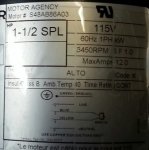Hello, My wife decided we needed a 24' pool and BAM  were having one installed this week.... The installers are wanting electric ran to the location which I'm a DIY and that's no problem but I'm confused on what all needs done. First off at the location I will be having a pool pump and a electric heat pump and I also need a convenience outlet so I want it there as well.
were having one installed this week.... The installers are wanting electric ran to the location which I'm a DIY and that's no problem but I'm confused on what all needs done. First off at the location I will be having a pool pump and a electric heat pump and I also need a convenience outlet so I want it there as well.
Now I opened the pump box and it has a 3 prong plug on the end not a twist lock like I have been reading that is required for pools so that's issue one. Second, is Do i just get a GFCI breaker at the service panel run the wire or use a regular breaker and GFCI at the outlet?
Next, the Heat pump. It mentions nowhere it needs to have a GFCI do I need one? Also, should I run a 25 amp or 30 amp breaker?
Last... What would be the best way to wire this? Thanks.....
Specs Of Parts:
Pentair Sand Dollar 22" Sand Filter with 1-1/2 hp Dynamo Pump .PDF
Aqua Pro 500 Heat Pump .PDF
 were having one installed this week.... The installers are wanting electric ran to the location which I'm a DIY and that's no problem but I'm confused on what all needs done. First off at the location I will be having a pool pump and a electric heat pump and I also need a convenience outlet so I want it there as well.
were having one installed this week.... The installers are wanting electric ran to the location which I'm a DIY and that's no problem but I'm confused on what all needs done. First off at the location I will be having a pool pump and a electric heat pump and I also need a convenience outlet so I want it there as well. Now I opened the pump box and it has a 3 prong plug on the end not a twist lock like I have been reading that is required for pools so that's issue one. Second, is Do i just get a GFCI breaker at the service panel run the wire or use a regular breaker and GFCI at the outlet?
Next, the Heat pump. It mentions nowhere it needs to have a GFCI do I need one? Also, should I run a 25 amp or 30 amp breaker?
Last... What would be the best way to wire this? Thanks.....
Specs Of Parts:
Pentair Sand Dollar 22" Sand Filter with 1-1/2 hp Dynamo Pump .PDF
Aqua Pro 500 Heat Pump .PDF


